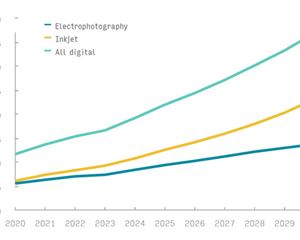Bobst powers Weepac’s novel venture into paperboard-plastic combo cartons
With a brand new set-up, Weepac offers an alternative to PP boxes and window-patched cartons combining the advantages of paperboard and plastic, discovers Rushikesh Aravkar.
16 Jan 2017 | By Rushikesh Aravkar
Surat’s Naimesh Naik has been a disruptor in his entire career. He is best known for pioneering UV printing in Surat’s textile packaging market.
Naik’s firm, Imprint, at its peak in 2015, consumed 3.5 tonnes of UV ink per month running the press 24/7 putting ink on paper. The firm deployed a 20x28-inch Mitsubishi five-colour plus coater press and a 28x40-inch six-colour plus coater Komori press and a lamination machine.
“We had mastered UV. We were churning out 60,000 UV printed MetPET sheets in a 24-hour production for over five years. We had acquired 40% market share of UV printing in Surat. Plus, MetPET and UV were becoming mainstream but growth was stagnant. All that could be done with UV had already been done. It was high time we climbed the next level. I wanted a niche ground to play and grow big.”
Now, when Naik realised that the firm had exhausted all the room for scaling up further, he came up with an unconventional plan – a new venture called Weepac.
“We completely stopped production in 2015 to work on this innovative idea,” says Naik. “I wanted to go slow to go big.”
The idea was to produce dual-material packaging cartons that combine paperboard and clear, rigid plastic to create a package, which forms an alternative to PP cartons and window-patched paperboard cartons.
“In India, clear cartons are used for suiting, shirting and undergarment packaging applications wherein white PP is printed and heat sealed to clear PP to form a carton.”
“The issue with such cartons is that the white PP has decorative limitations and clear PP is not as clear as transparent PET; and you cannot combine transparent PET with white PP as two different plastic materials will make a poor seal. That’s why the clear plastic cartons have limited shelf appeal.”
“When I saw the pick and place machine at Drupa 2012, I saw a solution to combine decorative effects on paperboard with transparent nature of PET to form attractive shelf ready packaging,” remembers Naik.

The combination of paperboard and plastic enables numerous structural possibilities and out-of-the-ordinary visual effects that would not be possible with either substrate alone. So, Weepac was established in January 2016 and Naik started adding machines and investing in people.
Solid set-up
Naik’s self-financed project Weepac has invested in top-notch equipment: a brand new pick-and-place machine from Esatec, France, a Bobst Novacut 106 die-cutter, a Bobst Visionfold 110 folder-gluer with four and six corners attachment and plastic kit, plastic sheet straightening machine, and a soft creasing machine.
“When you are new to a process and technology, go for the best available one,” says Naik explaining his rationale behind investing in high-end Bobst post-press equipment. “We know printing and hence for the time being, the existing machines could suffice. However, we have zero experience in finishing of printed sheets so I wanted the finest equipment.”
“Secondly, when you invest in a new process, you want a supplier who becomes your technical partner and helps you with all the necessary process support. And finally, I was building an entirely new set-up so I was looking for robust equipment which could serve hassle-free for at least 10 to 15 years. Thus, Bobst was the only one which fitted the bill.”
When PrintWeek India team visited Weepac in December 2016, the production had started at its 30,000 sq/ft factory. It has a capacity of producing one lakh to three lakh combo cartons per day, depending on the size of the cartons.
However, Naik still wants to go slow. “This is an innovative product. We are the only company in the country which can produce combo-cartons with finest soft creasing and fastest turnaround. The combo carton is an appealing product but it is expensive. So we need to make extra efforts to convince the clients.”
Weepac has also invested in a sample maker from Italian manufacturer Valiant, which it uses along with Angview and PaSharp software packages to create prototype cartons for its potential clients’ products. “When the clients see their product in the combo cartons, that’s when they realise the value in it,” adds Naik.
By the end of 2017, Weepac will add a six-colour plus coater offset press, which is a final piece that remains in order to set its route to new turf, where it aims Rs 50-crore turnover by 2019.












 See All
See All